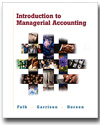 Introduction to Managerial Accounting Jeannie M. Folk
Ray H. Garrison
Eric Noreen
Systems Design: Job-Order Costing
Learning ObjectivesAfter studying Chapter 2, you should be able to:
1Distinguish between process costing and job-order costing and identify companies that would use each costing method. |
 |  |  | 2Identify the documents used in a job-order costing system. |
 |  |  | 3Compute predetermined overhead rates and explain why estimated overhead costs (rather than actual overhead costs) are used in the costing process. |
 |  |  | 4Prepare journal entries to record costs in a job-order costing system. |
 |  |  | 5Apply overhead cost to Work in Process using a predetermined overhead rate. |
 |  |  | 6Prepare T-accounts to show the flow of costs in a job-order costing system and prepare schedules of cost of goods manufactured and cost of goods sold. |
 |  |  | 7Compute under- or overapplied overhead cost and prepare the journal entry to close the balance in Manufacturing Overhead to the appropriate accounts. |
| 



 2002 McGraw-Hill Higher Education
2002 McGraw-Hill Higher Education